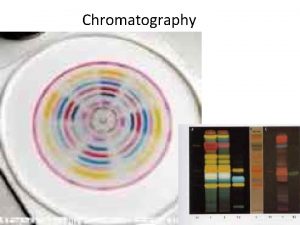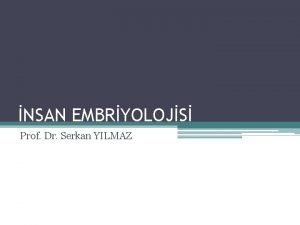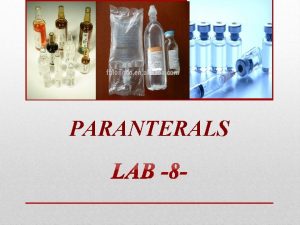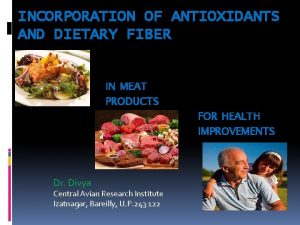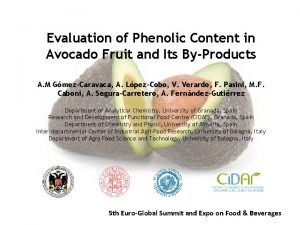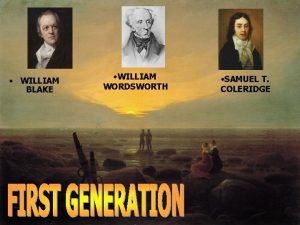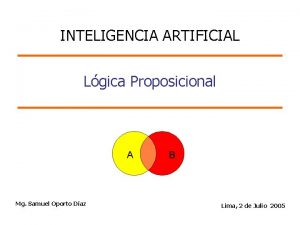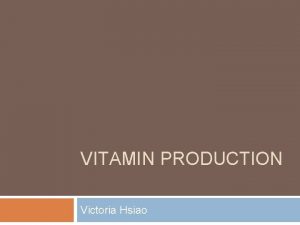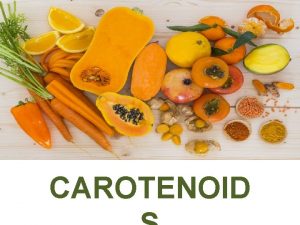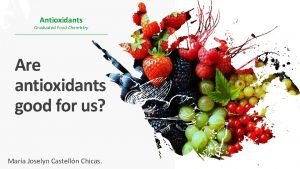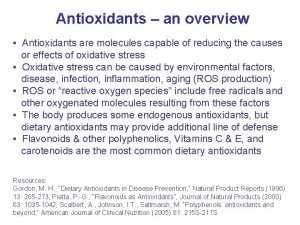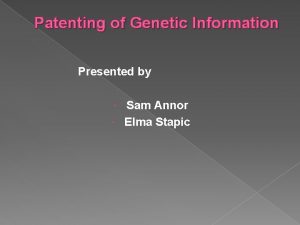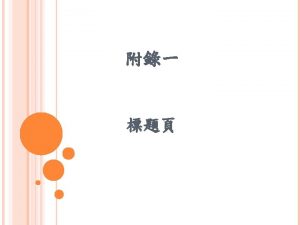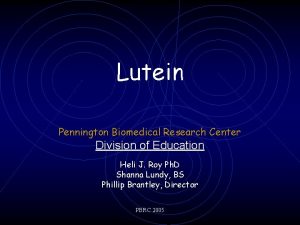Lutein and Other Carotenoids as Antioxidants Samuel Annor














- Slides: 14

Lutein and Other Carotenoids as Antioxidants Samuel Annor April 4, 2019

Introduction • Carotenoids are organic pigments that are produced by plants, algae, and some species of bacteria and are responsible for many of the red, orange, and yellow colors of fruits, flowers, and plant leaves. • They are among the most common natural pigments, with over 600 different compounds characterized (1). • Β-carotene is the most prominent. • Only plants, bacteria, fungi, and algae can synthesize carotenoids; many animals get them from their diets. • In general, carotenoids serve two key roles in plants and algae: • they absorb light energy for use in photosynthesis, and they protect chlorophyll from photo damage

Carotenoids: the chemistry • Carotenoids are a class of hydrocarbon compounds consisting of 40 carbon atoms (tetraterpenes), with a structure characterized by an extensive conjugated doublebond system that determines the color (it serves as a light-absorbing chromophore) • As the number of conjugated double-bond increases, color changes from pale yellow, to orange, to red. • Carotenoids are usually lipophilic due to the presence of long unsaturated aliphatic chains as in some fatty acids. • The general structure of the carotenoid is a polyene chain consisting of 9 -11 double bonds and possibly terminating in rings. • This structure of conjugated double bonds leads to a high reducing potential, or the ability to transfer electrons throughout the molecule (3).

Carotenoids: chemical formula • Carotenoids have unique chemical structure which determines their potential biological functions and actions. • As a class, they are terpenoids and are based on a structure having the formula C 40 H 56. • Structure includes a system of conjugate double bonds. • According to the number of double bonds, several cis/trans (E/Z) configuration are possible for a given molecule

Carotenoids: general chemical structure General structure of a carotenoid: polyene tail with double bonds, possible terminal rings

Classification Based on their composition, carotenoids are classified into two general classes of carotenoids: carotenes and xanthophylls. • Carotenes consist only of carbon and hydrogen atoms. • Β-carotene is the most prominent carotene. • Xanthophylls have one or more oxygen atoms. • Lutein is one of the most common xanthophyll.

Lutein • Lutein is a xanthophyll and is synthesized only by plants. • It is found in high qualities in green leafy vegetables such as spinach and yellow carrots. Also found in egg yolks and animal fats. • A lipophilic molecule and is generally insoluble in water. • Chemical formula is C 40 H 56 O 2 • It is isomeric with zeaxanthin, differing only in the placement of one double bond. • Lutein and zeaxanthin can be interconverted in the body through an intermediate called mesozeaxanthan (6)

Lutein contd • This zanthophyll (like zeaxanthin) has primarily been used in food and supplement manufacturing as a colorant due to its yellow-red color. • Lutein absorbs blue light and therefore appears yellow at low concentrations and orange-red at high concentrations. • The presence of the long chromophore of conjugated double bonds (polyene chain) provides the distinctive light-absorbing properties. • Lutein bears on hydroxyl group on each ionone ring and therefore can be esterified with fatty acids in plant cells.

Lutein: chemical structure

Antioxidant Properties/Activities • The pattern of conjugated double bonds in the polyene backbone of carotenoids determines their light absorbing properties. This influences the antioxidant activity of carotenoids. • Carotenoids play a major role in the protection of plants against photo oxidative processes. They are efficient antioxidant scavenging singlet molecular oxygen and peroxyl radicals. • In humans, carotenoids are part of the antioxidant defense system. • The strongest evidence came from studies showing that carotenoid pigments can quench singlet, excited oxygen (7). • There is increasing evidence from human studies that carotenoids protect the skin against photo oxidative damage.

Carotenoids as Antioxidants • Carotenoids have an important antioxidant function of deactivating free radicals-- single oxygen atoms that can damage cells by reacting with other molecules (5). • At present, it is unclear whether the biological effects of carotenoids in humans are related to their antioxidant activity and/or other non-antioxidant activities (5). • Carotenoids that contain unsubstituted beta-ionone rings (including beta-carotene and alpha-carotene) have vitamin A activity (meaning that they can be converted to retinol), and these and other carotenoids can also act as antioxidants(2). • Carotenoids also have anti-inflammatory and immune system benefits and are sometimes associated with cardiovascular disease prevention. • Studies have also shown that they have preventive effects against cancer, cardiovascular and ophthalmological diseases and these effects have been associated with their antioxidant activity (9).

Carotenoids as Antioxidants • Carotenoids are pigments which play a major role in the protection of plants against photo oxidative processes. • They are efficient antioxidants scavenging singlet molecular oxygen and peroxyl radicals. • In the human organism, carotenoids are part of the antioxidant defense system. • They interact synergistically with other antioxidants. There is increasing evidence from human studies that carotenoids protect the skin against photo oxidative damage.

Conclusion • Carotenoids have unique chemical structures which make them efficient antioxidants. • They protect plants against oxidative damage. • They are part of the antioxidant defense system in animals and humans. • They possess roles in the oxidant network such as protecting lipophilic compartments or scavenging reactive species generated in photo oxidative process. • They limit light exposure and thereby prevent oxidative stress.

References 1. Yabuzaki J. “Carotednoids Database: structure, chemical fingerprints and distribution among organisms”. Database. 2017 (1). 2. Bernstein PS, Li B, Vachali PP, Gorusupudi A, Shyam R, Henriksen BS, and Nolan JM (2015). “Lutein, Zeaxanthin, and meso-Zeaxanthin: Basic and Clinical Science Underlying Carotenoid-based Nutrition Interventions against Ocular disease. Progress in Retinal and Eye Research. 50: 34– 66. 3. Vershinin A (1999 -01 -01). "Biological functions of carotenoids - diversity and evolution". Bio. Factors. 10 (2– 3): 99– 104 4. Cogdell RJ (1978 -11 -30). "Carotenoids in photosynthesis". Phil. Trans. R. Soc. Lond. B. 284 (1002): 569– 579. 5. Linus Pauling Institute. “Micronutrient Information Center-Carotenoids”. Retrieved April, 2019. 6. Krinksy N, Landrum J, Bon R (2003). "Biological Mechanisms of the Protective Role of Lutein and Zeaxanthin in the Eye". Annual Review of Nutrition. 23 (1): 171– 201 7. Krinsky NI. Antioxidant functions of carotenoids Free Radic Biol Med, 7 (1989), p. 617 8. Stahl W, Sies H. Molecular Aspects of Medicine. Volume 24, Issue 6, December 2003, Pages 345 -351 9. Sies H, Stahl W. Vitamins E and C, beta-carotene, and other carotenoids as antioxidants. Am. J. Clin. Nutr. , 62 (1995), pp. 1315 S-1321 S 10. Young AJ, Lowe GM. Antioxidant and prooxidant properties of carotenoids. Arch. Biochem. Biophys. , 385 (2001), pp. 20 -27 11. Palozza P. Prooxidant actions of carotenoids in biologic systems. Nutr. Rev. , 56 (1998), pp. 257 -265 •
 In hptlc gas used as pressure on linomat
In hptlc gas used as pressure on linomat Primordial folikül
Primordial folikül Antioxidants used in parenterals
Antioxidants used in parenterals Vitacel wheat fiber
Vitacel wheat fiber Avocado antioxidants
Avocado antioxidants Habla señor que tu siervo escucha dibujo
Habla señor que tu siervo escucha dibujo Other initiated other repair
Other initiated other repair Sue and samuel
Sue and samuel William blake and samuel taylor coleridge
William blake and samuel taylor coleridge Daz samuel
Daz samuel Chapter 7 balancing nationalism and sectionalism
Chapter 7 balancing nationalism and sectionalism Wanda jean allen
Wanda jean allen Samuel zats
Samuel zats Samuel alberg
Samuel alberg Saul desobedece
Saul desobedece
